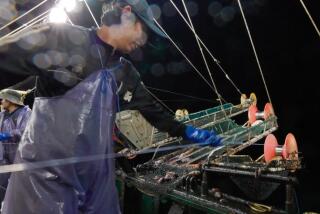Watching for Anything Fishy . . . : Enforcement: A thin line of clipboard constables monitors the balance between the commercial boats and the supply of prey in the sea.
- Share via
SEATTLE — Between America’s ravenous fishing fleet and the continued abundance of Alaska’s billion-dollar fish stocks stands a line of young constables with clipboards, an unlikely contingent of high-seas biologists called federal observers.
They work alone aboard hundreds of fishing vessels that ply an area of the North Pacific more than twice the size of Alaska itself. They brandish nothing more threatening than a log book and weight scales. Yet their findings have the power to bring an entire fishing season to a halt, and send vessels back to port half empty.
With the Coast Guard stretched thin across the huge expanse of Alaskan waters, it falls to these seasonal employees, up to 300 at any time, to keep fish and fishermen in balance. For weeks-long stretches they endure the common hardships and dangers of a fisherman’s life, the bitter weather and profound loneliness. As often as four times a day they sift by hand through half-ton samples from the trawl net, identifying, measuring, weighing and sorting fish.
This is the way the government patrols the North Pacific fisheries for over-exploitation.
Fisheries managers rely on the observers’ data to set harvest quotas, and observers keep an especially close watch on the killing or harming of marine mammals.
But most crucial to fishermen and managers alike is the observer’s tally of untargeted fish species incidentally brought up in the net. Pollock trawlers, for example, must try to avoid catching halibut or salmon, which must be thrown back, dead or alive. If this “by-catch” becomes excessive, fishing seasons for the whole fleet can be closed weeks early. In some cases, crippling fines are levied against the offending boat.
Though observers have peered over the shoulders of captain and crew in these teeming ground fisheries for decades, they are largely unknown outside the fishing industry. The system depends completely on their competence and integrity, and some critics warn that the arrangement could become vulnerable to corruption.
Observers are recruited through colleges, and a degree in fisheries or some other biological science is mandatory. Trained ashore for three weeks in Seattle, they are then scattered among the fleet for stints of up to three months. Wages start at about $2,400 per month, paid by the vessel owners themselves, as required by law.
The observers are usually young, mostly single, often female. Always, the observer is the outsider among the crew, whose data can make the difference between a long profitable season and a costly trip cut short.
And everyone on board knows it.
The conflicting role observers often play can seem threatening to the fishermen they work with, provoking attitudes ranging from grudging respect to full-frontal hostility. “They’re on everybody’s hit list,” says Michael Lake, owner of a Seattle company that recruits and contracts observers.
Most of them can tell tales of indignities and intimidation. One young female observer had to eat her meals under the blue glow of the crew’s favorite pornographic videos. Another discovered that a light bulb was somehow activated in the wheelhouse whenever he left his bunk, alerting the captain to his presence on deck.
Often, the observers say, their greatest challenge is to gain acceptance from working commercial fishermen.
“It’s a strange situation, being there on a boat when they don’t want you there,” reflected Jeff Jennings, 24, who has observed on seven boats in the last year.
A large but undetermined number of observers are Peace Corps veterans. Contractor Michael Lake says it’s the best preparation possible for the job. “They were in Third World countries, so they had to be self-reliant.”
Observers are issued all the necessary sampling gear and protective outer wear, about $2000 worth, before putting out to sea. They only have to supply their own work clothes. And they must bring along seasick medication.
Seasickness can be a serious problem for first-timers, and some never overcome it. The topic is covered the very first day of observer training. Once at sea, “they’re not ever prepared for it,” said Lake. “I mean, they can’t keep soda crackers down. We get faxes saying, ‘Can you get me off of here?’ ” The answer is almost always no.
If there’s a better way to protect fish populations, neither industry nor government has seriously considered it.
“It’s a people program, and with people there will always be problems,” said Dave Cormany, a federal fisheries manager in Juneau and a former observer. “But there are observer programs all over the world. And they are there because there’s no other way to do it.”
More to Read
Sign up for Essential California
The most important California stories and recommendations in your inbox every morning.
You may occasionally receive promotional content from the Los Angeles Times.













